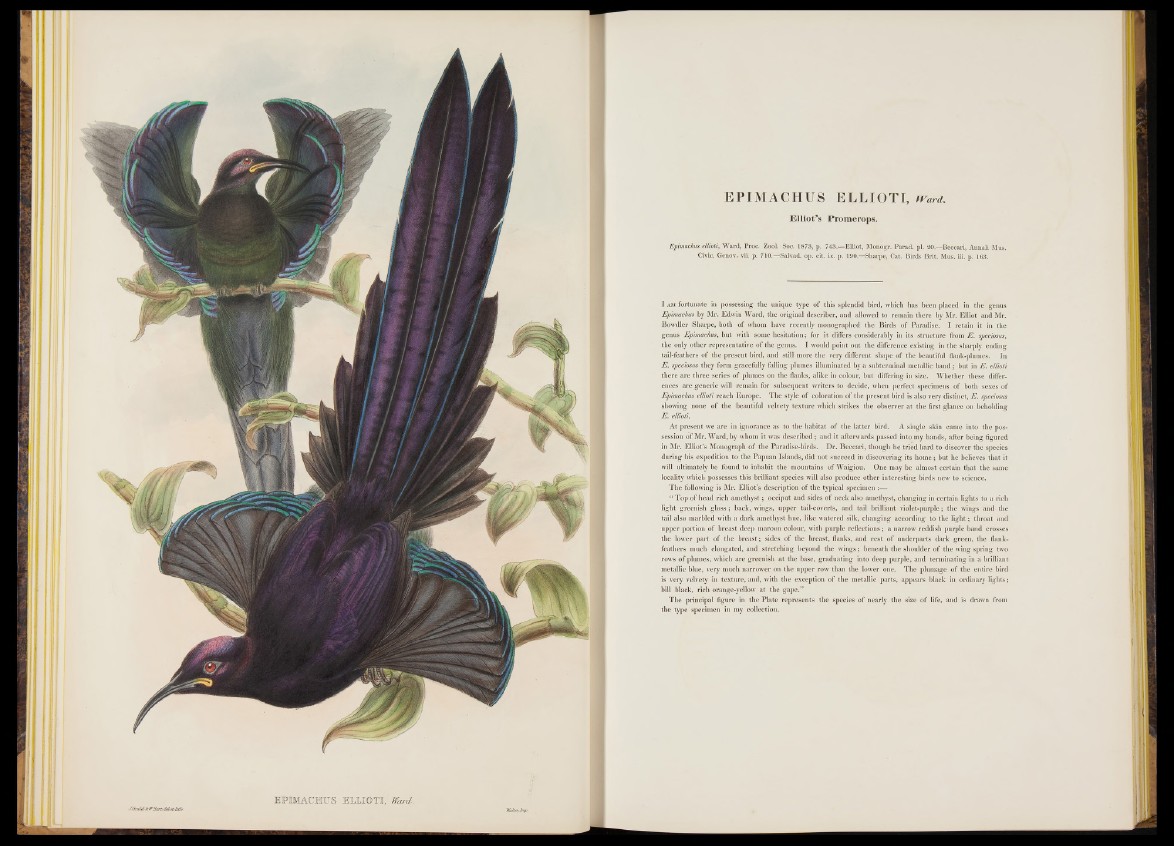
EPIMACBXTS ELLIOTI, Ward,.
JOmdä, kW B art'.deiet’h th '. Walter,bnp
EPIMACHUS ELLIOTI, Ward.
Elliot’s Promerops.
Epimachus ellioti, Ward, Proc. Zool. Soc. 1873, p. 743.—Elliot, Monogr. Parad. pi. 20.—Beccari, Annali Mus.
Civic. Genov, vii. p. 710.— Salvad. op. cit. ix. p. 190.—Sharpe, Cat. Birds Brit. Mus. iii. p. 163.
I a m fortunate in possessing the unique type o f this splendid bird, which has been placed in the genus
Epimachus by Mr. Edwin Ward, the original describer, and allowed to remain there by Mr. Elliot and Mr,
Bowdler Sharpe, both of whom have recently monographed the Birds o f Paradise. I retain it in the
genus Epimachus, but with some hesitation; for it differs considerably in its structure from E . speciosus,
the only other representative o f the genus. I would point out the difference existing in the sharply ending
tail-feathers o f the present bird, and still more the very different shape of the beautiful flank-plumes. In
E . speciosus they form gracefully falling plumes illuminated by a subterminal metallic band; but in E . ellioti
there are three series o f plumes on the flanks, alike in colour, but differing in size. Whether these differences
are generic will remain for subsequent writers to decide, when perfect specimens o f both sexes of
Epimachus ellioti reach Europe. The style o f coloration o f the present bird is also very distinct, E . speciosus
showing none o f the beautiful velvety texture which strikes the observer at the first glance on beholding
E . ellioti.
At present we are in ignorance as to the habitat of the latter bird. A single skin came into the possession
of Mr. Ward, by whom it was described; and it afterwards passed into my hands, after being figured
in Mr. Elliot’s Monograph o f the Paradise-birds. Dr. Beccari, though he tried hard to discover the species
during his expedition to the Papuan Islauds, did not succeed in discovering its home; but he believes that it
wjill- ultimately be found to inhabit the mountains o f Waigiou. One may be almost certain that the same
locality which possesses this brilliant species will also produce other interesting birds new to science.
The following is Mr. Elliot’s description of the typical specimen :—-
“ Top o f head rich amethyst; occiput and sides o f neck also amethyst, changing in certain lights to a rich
light greenish g lo ss ; back, wings, upper tail-coverts, and tail brilliant violet-purple; the wings and the
tail also marbled with a dark amethyst hue, like watered silk, changing according to the lig h t; throat and
upper portion o f breast deep maroon colour, with purple reflections; a narrow reddish purple band crosses
the lower part o f the breast; sides o f the breast, flanks, and rest o f underparts dark green, the flank-
feathers much elongated, and stretching beyond the wings; beneath the shoulder o f the wing spring two
rows o f plumes, which are greenish at the base, graduating into deep purple, and terminating in a brilliant
metallic blue, very much narrower on the upper row than the lower one. The plumage of the entire bird
is very velvety in texture, and, with the exception o f the metallic parts, appears black in ordinary lights;
bill black, rich orange-yellow at the gape.”
The principal figure in the Plate represents the species of nearly the size o f life, and is drawn from
the type specimen in my collection.